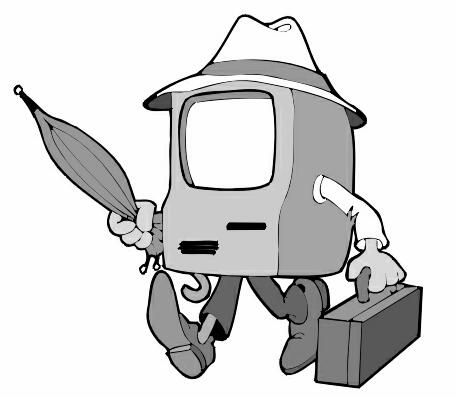
H. James Boynton
Computer Consultant
994 Willowood Lane
Dunedin, Fl 34698
727-734-8661
Jim?s Computer Jungle This is an article that was printed in the Dunedin Times in January 2000
By now everyone who does not live in a cave must have heard about the Internet. Since there are very few caves around Dunedin, I am sure that all have some knowledge of the Internet, or have at least heard about it on the news. All of the recent coverage of the Y2K bug, made people who do not even touch computers talk and think about the Internet. Recently President Clinton has started preparing the government to prevent Internet terrorism. With this increased interest, it is a good time to take a better look at this phenomenon of the 1990?s.
If two or more computers are connected to share data, software, or resources, this is a network. If these computers are in different cities, it is a Wide Area Network (WAN), and if these computers are all over the world, it is a World Wide Web (WWW) or the Internet.
The present Internet can trace its roots back to the late 50?s when President Dwight Eisenhower established the Advanced Research Project Agency (ARPA) under the Department of Defense. Part of the job of ARPA was to coordinate research at a number of universities and defense contractors around the country following the Soviets surprise launch of the Sputnik satellite. By the end of the 60?s this research was starting to be sent in small data packets across telephone lines to computers located at another university in a different city. This was the start of the ARPANet.
With the development of Transmission Control Protocol (TCP), which is a set of rules, like football or baseball, and when everyone understands the rules and plays by them the game goes on much better. Under TCP data is broken into small packets, which are addressed and sent to another computer, where the packets are checked and reassembled into the original data. This allowed smooth flow of data between computers located all over the world. As more computer networks were linked together, webs were starting to form. An Internet Protocol (IP) was developed to route packets around these fledgling webs. Combining these two protocols into the TCP/IP made the WWW as we know it today a reality.
In 1991 the National Science Foundation, who inherited the ARPANet, lifted commercial restrictions on the Internet, and the rush has been on ever since. It is now estimated that about one third of the households in America are on the Internet, and that number is growing everyday.
The question arises as to who owns the Internet. Since the Internet is a collection of computers and the connections between them, nobody owns the Internet, just small parts of it. The Internet itself is often referred to as a "The Cloud" or cyberspace. An Internet Service Provider (ISP) establishes a connection for the individual computer user to this cyberspace.
Once a data request is prepared and addressed, it is transmitted to the ISP and on to the Internet. This request travels over a variety of telephone lines, fiber optic cables, and even satellite links. This request can travel to the other side of the world at almost the speed of light. When this request reaches its destination, a reply is sent back as a series of packets, which might take a very different path to reach its destination. When this data reaches the original computer, it is reassembled and displayed on the computer screen. Exactly how a message travels on the Internet is of very little concern. In other words, small electronic messages are sent off into cyberspace. Other computers called routers keep the message moving over the best route until it reaches its destination. The destination computer puts the reply message into cyberspace and it finds the best route back to the original computer. This entire part of the process is like computer orchestrated magic, and fortunately the computer operator does not need to know how it works to take advantage of this modern means of communication.
Email is a form of electronic mail that is sent over the Internet. It is very fast and an easy way to keep in touch with friends and relatives. Email is altering the way that people in America are communicating, because it is easy and free.
A couple of cautions are in order in any discussion of the Internet. First of all it can become addictive. There is so much information out there, and so many interesting and fun websites available that hours can be spent without realizing it.
Although an ISP is needed to access the Internet, there are a number of local companies that offer better Internet services than the big national ISPs at a fraction of the cost. So before someone signs a 3 year contract with a national ISP for a $300 rebate, some math should be considered. What will this service cost for 3 years, and what happens if I do not like this service?
If one does not mind putting up with a banner ad being placed on their computer screen while they are on the Internet, there are ISPs that will provide services for free.
There are many people who are not on the internet still who are trying to decide if they should take the plunge, and all I can say is that I am sure that anyone will benefit from the opportunities available on the Internet. On the other side, I would like warn that it is not as easy to learn how to navigate around the Internet as the companies selling the computers make it sound, so plan to spend many hours learning how to use this new tool or hobby. Anything worth doing will take some time to master.
Return to Boynton Home PageCLICK
Return to Boynton Resume PageCLICK